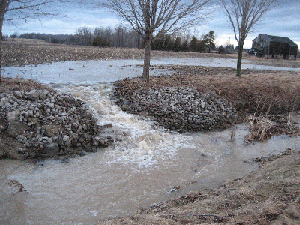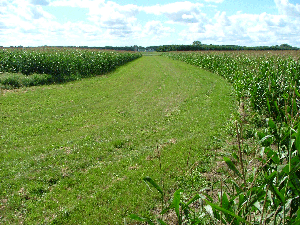Respecting the power of water
SOIL EROSION IS BEST TACKLED SOONER THAN LATER
soil erosion by water is an important concern on many farms across Ontario – whether realized or not.
“Although most operations have adopted some form of conservation management, especially where soils or slopes increase the risk, it’s very common to find isolated erosion problems that need to be addressed,” says Brad Glasman, coordinator of conservation services at the Upper Thames River Conservation Authority in London.
The intense storm events we are experiencing nowadays, along with multiple ‘spring’ runoffs, make it more difficult to control soil erosion, but doing so is critical to the success of your farm business.
“Solutions may be simple and not that costly,” says Glasman, “Especially when you compare these to the true cost of erosion problems.” He notes that farmers who ‘work around’ the problems – basically avoiding those parts of the field while the problems get worse – are making a mistake. “There’s a lot of time and fuel wasted going around these areas, but what’s more troublesome,” he says, “is the loss of topsoil and effects on soil health that lead to yield losses, and the loss of nutrients through fertilizer run-off.” Farmers who ‘work around’ erosion problems also often have to worry about things like keeping municipal drains clear from sediment – on a yearly basis.
Ironically, farmers usually put off dealing with erosion problems because of the cost, Glasman observes, “But in the long run, the problem expands and usually therefore costs much more to mitigate.”
tackling erosion problems
The first thing growers need to consider is their tillage system. “Conservation tillage and crop rotation are the foundations of soil protection,” Glasman notes. “Cover crops, perennial crops, no-till, mulch-till and rotations all build soil strength and help prevent erosion from occurring.”
These practices are effective at preventing sheet erosion, where layers of soil are lost year after year. “Low to moderate sheet erosion is difficult to see because the soil is removed a little at a time, but it’s easy to see it if the extent is severe,” observes Glasman. “You’ll notice sedimentation at the bottom of the slope with no apparent rills or gullies, light coloured knolls, and low yields on shoulder slopes.”
Rill erosion requires different action. Rills are distinct finger-like ruts where the soil has been washed away (a gully is a rill you can no longer drive through), and are common in areas with large contributing watersheds, steeper slopes and confined drainageways. “Where it appears in a watershed of less than five acres and/or with broad drainageways, consider double cropping wheat and leaving drainageways in permanent grass or untilled,” says Glasman. In more serious cases, water should be safely diverted to a different location, such as underground into a tile drain.
ROCK-LINED SPILLWAY:

Where rill erosion is occurring in watersheds of up to 25 acres or more, farmers can construct an earthen berm (or series of them) across the natural drainageway. “Attempt to build the berm in the same direction as the field is cropped,” says Glasman. Water and sediment control basins can also be used to control rill erosion along headlands.
Rills and gullies can also occur along streams and ditches. “In many cases, well-vegetated banks and buffer strips are often all you need to achieve watercourse stability,” says Glasman. “Where concentrated overland flow is a problem, construct a rock-lined spillway that is adequately-sized and made of properly-sized stone underlain with filter cloth.” He also suggests a diversion along the top of the bank to direct flow to as few locations as possible before allowing it to flow over the bank and into the watercourse.
There are other erosion problems common to many farms related to runoff from roads, lanes and neighbouring properties. Clean water in these cases can be intercepted and redirected to a safe outlet or into a tile drainage system. Along roadways, small berms with surface inlets can intercept culvert flow and direct it underground. Around buildings, installing eavestroughs wherever possible will contain some water, and blind inlets can also be helpful. Another option is to direct water into a grass waterway and to a safe outlet.
For those ready to tackle erosion problems, there is potential financial help. Using Environmental Farm Plan cost-share funding is an excellent way to defray costs, and Glasman also advises talking to your local conservation authority about grants that may be available.
using grassed waterways to control erosion
Where erosion is being experienced in a large watershed of more than 35 acres, a grassed waterway (a broad, shallow, permanently vegetated channel) will safely convey concentrated runoff from farm fields to a stable outlet. The waterway will follow the natural drainageway, preventing rill and gully erosion.

Sideslopes of 10:1 (horizontal:vertical) are recommended, allowing farm machinery to easily pass, with drainage tile placed underneath.
To maintain the long-term functioning of the grass waterway:
- Raise farm implements when crossing the waterway
- Harvest forage crops from the grassed waterway
- If possible, bring crop rows into the waterway at an angle
- Grow dense, vigorously growing grass
- Don’t spray with herbicide
- Don’t use the waterway as a travel lane or as a turn strip during field operations
- Don’t establish head rows along the waterway •






















